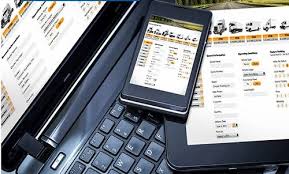Have you ever heard the term “wearable technology” but didn’t know what it meant? Wearable technology is a broad term for a group of gadgets that are meant to be worn all day, like fitness trackers and smartwatches. Wearables is a short name for these gadgets. This article explains the meaning of wearable technology in health care, fitness, and sports, as well as an example of wearable technology.
Wearable Technology
Wearable technology, often known as “wearables,” refers to a class of electronic devices that may be worn as accessories, incorporated into clothing, placed in the user’s body, or even tattooed on the skin. The gadgets are useful, can be used without using your hands, and are capable of transmitting and receiving data through the Internet.
Wearable technology has been around since the 13th century when the first sunglasses were made. Since about 1500, people have been able to wear small clocks. But the definition of current wearable technology is that it has a microprocessor and a way to connect to the internet.
The development of mobile networks made wearable technology possible. The first big wave of wearable technology that caught on with customers was fitness activity trackers. Then, the watch turned into a screen, and better mobile apps were added. People can get information from Wi-Fi networks with Bluetooth headsets, smartwatches, and glasses that can connect to the web. With virtual reality and augmented reality headsets, the gaming business is adding more things that can be worn.
Wearable Technology Health Care
In healthcare, “wearable technology” refers to devices that people can put on their bodies to track their health and fitness. They can then give this information to their doctors, health care providers, insurers, and other relevant parties. Fitness watches, blood pressure monitors, and biosensors are all examples.
Wearable healthcare equipment like exercise trackers, smart watches, electrocardiogram (ECG) monitors, blood pressure monitors, and biosensors has become very popular because of these benefits. In 2020, the market for smart wearable health products will be worth $13.8 billion. By 2028, it is expected to be worth $37.4 billion. Here are the companies that contribute to this growth by changing the way patients experience healthcare through wearable technology.
#1. Silvertree
Location: Cambridge, Massachusetts
Older active adults can track their health and safety using the Silvertree Reach, made by the health tech company Silvertree. The Reach wristband is designed to help older people be more independent. It comes with a subscription service that enables the user to send an emergency message. It also has a GPS tracker in case of an emergency and a fall detector. The Reach app keeps track of your steps, stores your medical records and digital ID, and makes it easier to talk to your loved ones.
#2. Garmin
Location: Olathe, Kansas
Garmin makes a lot of different things, like health and fitness trackers that can be worn by both adults and children. Garmin also has an activity tracker that works all day and keeps track of steps, distance, intensity, and calories to help people meet their health and exercise goals. Wearable products from the company, like the Venu line, track body patterns, sleep quality, and heart rate. They also pair with Apple and Android smartphones to make things even easier.
#3. Withings
Location: Cambridge, Massachusetts
Withings is a health and wellness company based in France. Its goods keep people in touch with their health. Since making its first WiFi scale, the company has made other connected health products, such as watches that can track your health. Withings’ personal trackers can track your activities, give you an ECG, and keep track of your heart rate and sleep.
Read Also: ASSISTIVE TECHNOLOGY: Definition, Types, and Benefits
Wearable Technology Example
In the past few years, wearables have become more and more famous, but the idea behind them is not new. For example, if you’ve ever worn a watch, you’ve already used an easy wearable technology. The wearables of today can connect to your other devices, like computers and tablets, so they can do a lot of cool things.
Here are some examples of the different kinds of smart technology and how they make your life better.
#1. Smartwatches
These days, watches can be connected to technology. In addition to telling time, they can also track your health and watch how well you sleep. Smartwatches allow us to make and take phone calls, check texts, and do plenty of other things. Some watches can be used via a Bluetooth headset to play FM radio or music and video files. Most of the time, they link to a smartphone through an app and work as a support device. People often call them “wearable computers” because you can use the touchscreen to do a lot of different things.
#2. Fitness trackers
These are one type of wearable technology gadget that can be worn on the wrist. Fitness trackers were first made as pedometers, which count the number of steps you take. Since then, they have changed to become a general health monitor. They can track your heartbeat, sleep, calories burned, and other data. They send the information to the smartphone app. As a whole, they are a great way to track your health. Some devices can send information about the wearer’s metrics to their doctors on a regular basis to keep them updated and help them spot problems early.
#3. Smart Jewelry
Have you ever thought that your jewelry could let you know when you get a call or track your steps? Jewelry is no longer just a pretty thing to wear around your neck or hand. It has become smart. Smart jewelry includes things like pendants, wristbands, bracelets, and rings that can track your steps, heart rate, and sleep, and some can even let you know when you have a phone call.
#4. Game Simulators
The popularity of virtual reality (VR) games has led to the creation of many wearable devices that mimic an environment and make the game more real, interesting, and exciting. The devices include VR Headsets, which are also called Head-Mounted displays, or HMDs, and bands that have sensors built in to track your moves. With these bands, you can move around by making hand motions.
Read Also: Unveiling the Latest Trends in Mobile App Development for 2023
Wearable Technology for Fitness
Wearable technology for sports and fitness is slowly gaining popularity. There’s a tracker for everyone, whether you’re a gym rat who wants to keep track of your daily workouts or a sports fan who wants to get better at what you do. But we will list the wearable technology, fitness, and sports items that will help you stay fit.
#1. 4iii Sportiiii Sunglasses Mount
Have you ever been riding and just missed a car pulling out as you looked down at your watch to see how fast you were going or how fast your heart was beating? What if you could see all of the data about your workout right in front of you? With the Sportiii sunglasses clip, you can do that.
The Heads-Up in Sportiiiis Display clips onto your sports glasses and reads data from a heart rate monitor or other ANT+ devices. It then shows color LED images in front of you. So, it helps athletes meet their training goals for heart rate, speed, pace, cadence, and power by giving them feedback on their performance in real-time, anywhere, and at any time.
#2. Lumo Lift
“Sit up straight!” or “Don’t slouch!” These are some of the most common things our parents told us as kids. This is important because the way your body is positioned when you sit, stand, or lie down is very important for your health. When your bones, muscles, joints, and ligaments are all in the right place, you have good posture. However, bad posture can cause more problems than you think. Even if you only read or type for 15 minutes in the wrong position, your neck, shoulders, and upper back muscles will be tired.
Lumo Lift is made to help with this issue. The small device is placed just below the collarbone and keeps track of your core position, upper body position, and other posture details. The device is made up of two small parts: the tracker and a small magnetic plate. The tracker measures the slope at the top of your spine, while the magnetic plate measures where your shoulders, chest, and upper back are. The device’s biomechanics tracking sensors can tell when your body slouches and gently vibrates by measuring the angular displacement.
#3. Catapult Playr Smart Football Tracker
The Catapult Playr Smart Football Tracker might be for you if you want to know how many sprints you did, what your heatmap looks like, and how fast you run during a football game. This GPS tracker is approved by FIFA and fits in a vest that the player wears during a football game. It helps examine and improve football players’ performance by letting them see their speed, distance, power, sprint distance, load, intensity, and positioning on their smartphones.
#4. Tracker XMetrics Pro Swim
When you swim, your arms are always moving, and when you stop to check how you’re doing, you’re no longer moving toward your goal. Instead, you start to slow down because that out-of-place part is dragging you down. With the XMetrics Pro Swim Tracker, you’ll never have to slow down again. The Pro Swim Tracker is attached to your goggles and sits on the back of your head. This keeps it out of the way so that it doesn’t slow you down. The wearable fitness technology also gives real-time audio feedback that can be changed, just like a virtual coach, while swimming.
Read Also: SMART DEVICE: What It Is & Best Devices 2023
Wearable Technology for Sports
Here are some examples of wearable sports technology that will not only keep you fit but will also provide you with some really unique sports features.
#1. Sensoria Smart Socks
On the bottom of the Sensoria smart socks, there are three sensors. One is near the heel, and the other two are on the ball of your foot. Just wear them according to the “LEFT” and “RIGHT” signs, and each foot’s performance will be tracked separately. Then, a Bluetooth bracelet on top needs to be linked to your smartphone through the Sensoria App. It will track your foot landing, cadence, the speed at which you run, calories burned, distance, speed, ascent, and total steps.
#2. Hykso Boxing Wearable
Hysko’s wearable for boxing keeps track of punch data for serious boxers who spar with another person. It has two linked punch trackers that you can slip into your hand wraps once you’ve connected them. With just a tap, the blue and red lights on the tracker will turn on to show which one is for the left hand and which one is for the right. Then it’s time to put them on. You have to put them just below your hand so that they face your fist and make sure they are safe. When you are through, it will keep track of how many hits you threw, as well as their type and speed, and its partner app will show you your Intensity Score.
What Is the Most Popular Wearable Technology?
Smartwatches, fitness trackers, and head-mounted displays like smart glasses are some of the most popular wearable gadgets. These devices often track the biometric data of their users, allow them to use apps, and calculate or give them feedback about their actions.
What Does Wearable Technology Mean in Healthcare?
Wearable healthcare technology refers to health tracking devices that you can wear on the body, like on the wrist, to help keep track of the wearer’s health data. These devices use biosensors to receive information from the patient, such as heart rate, blood pressure, sleep patterns, and activity.
What Is the Oldest Wearable Technology?
Math professor Edward Thorp invents the wearable computer in the 1960s. Wearable technology became more popular and up-to-date over the next couple of decades thanks to a number of gadgets. The most well-known and well-known company produced the first, which was the calculator wristband.
What Is the Largest Wearable Brand in the World?
Among all the different types of products, smartwatches grew by 9.4% in 2022 and sold 148.6 million pieces, an all-time high. Apple was the leader in this category.
How Many Americans Have a Wearable Device?
By 2020, 30% of Americans will use wearable technology for health care. Nearly half of the people who use this technology do so every day, and more than 80% of them are happy to share the results with their doctor.
References
Related Articles
- AUTOMOTIVE TECHNOLOGY: What It Is, Education Requirement & Career You Can Pursue With It
- What Does Google Own? 17+ Companies You Didn’t Know
- Tory Burch Logo: The Full Story Behind Tory’s Success
- PRODUCT MARKET: Meaning, Examples, Market Fit, Survey, and Differences
- FITNESS AFFILIATE PROGRAMS: Best Fitness Affiliate Programs 2023/ Guide






